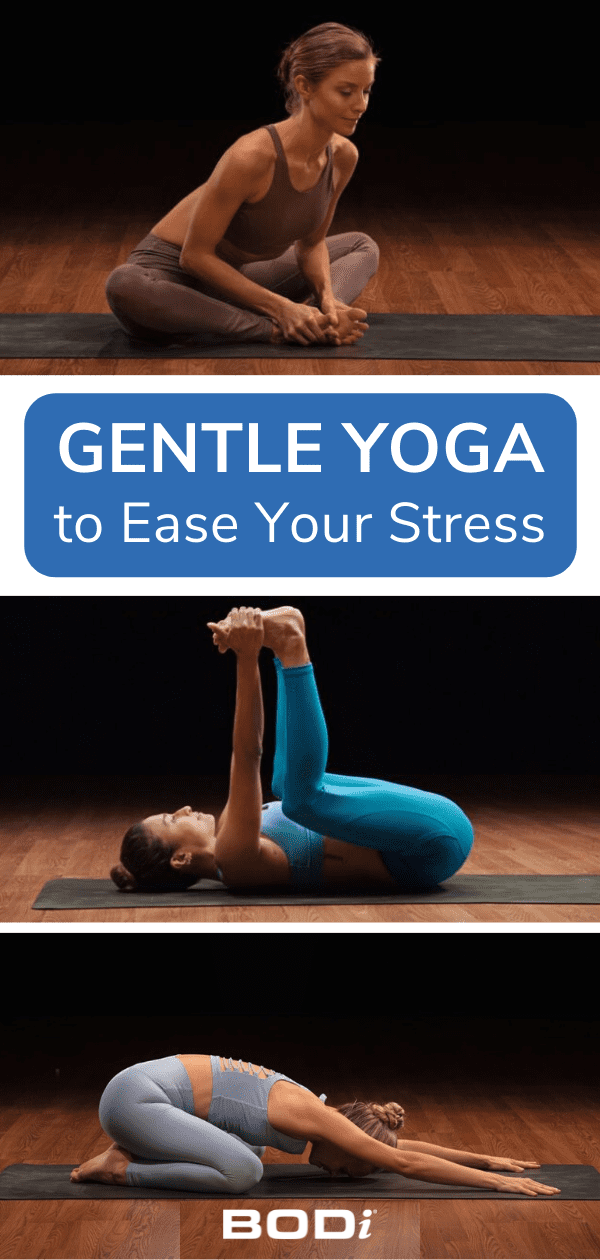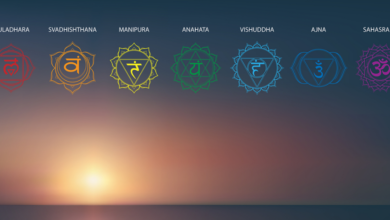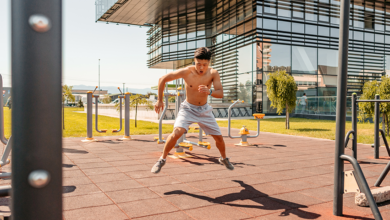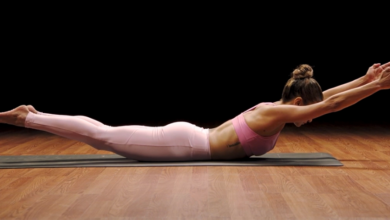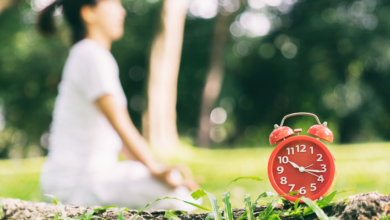Relieve Stress With These 8 Gentle Yoga Poses
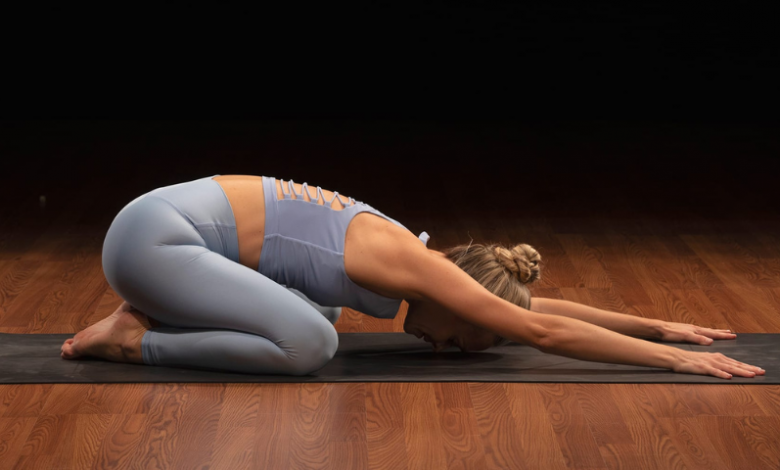
If you think yoga is all about handstands and contorting your body into near-impossible poses, you should know that there are several different ways to practice yoga. Gentle yoga, for example, is appropriate for just about anyone, beginners and veterans alike.
“Gentle yoga offers a nurturing and compassionate approach to the body,” says Sarah Cummins, RYT 500, E-RYT 200, YACEP, yoga instructor and certified personal trainer. “It’s often taught in a way that all people can easily participate.”
What Is Gentle Yoga?
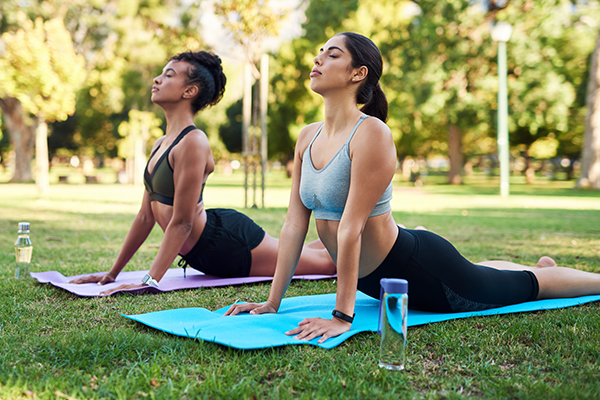
Gentle yoga is a slow, tranquil practice in which you typically hold poses for extended periods of time.
“Gentle yoga can be taught in a variety of ways, based on your instructor’s yoga style or lineage and experience,” Cummins says. “Gentle yoga may combine a slow flow with longer-held restorative positions that often include an emphasis on the breath as well as meditation practices.”
While each class will vary, here’s what you can expect in a gentle yoga class according to Cummins:
- Cues on how to safely and adequately align your body.
- Tips to use props such as blocks, straps, blankets, and bolsters to help with alignment and relaxation.
- Fewer transitions from sitting to standing or kneeling to lying down for a smoother, more relaxed experience.
- Lots of options and modifications to “meet you where you are and leave space for your exploration of poses,” she says.
Types of gentle yoga
Some yoga studios offer “slow flow” classes that are a gentler form of vinyasa yoga. And restorative yoga and yin yoga are both considered “gentle” yoga practices.
While both restorative yoga and yin yoga are gentle on the body, there are some differences between the two styles:
Restorative yoga: Incorporates roughly five or six postures that are intended to slow down and restore the body. Each pose is held for a couple minutes, using several props for support. The goal is total comfort so that you release all tension from your muscles.
Yin yoga: Holds fewer poses for longer periods (three-to-five minutes), but “you are penetrating to the deepest layers of connective tissue to bring elasticity, mobility, and energy back to tight muscles. Most yin poses are completed entirely on the floor and will most likely feel more challenging than those in restorative yoga,” Cummins says.
Is Gentle Yoga Good For Beginners?
Gentle yoga is an excellent entry point to yoga for beginners. “Gentle yoga allows students to move through postures slowly and mindfully and practice yoga in a safe and effective way,” Cummins says.
But it’s not only for newbies.
“It is a rewarding practice for the young and old, the flexible and inflexible. It’s also great for pregnant women and those recovering from injury,” she adds.
Gentle Yoga Sequence
Gentle yoga may include a blend of reclining, seated, and even standing or balancing poses. It’s simple to make any yoga practice gentler by adding props, not going as “deep” into a pose, or moving more slowly.
Along with more intense flows, Yoga52 and Beachbody Yoga Studio on BODi both offer soothing practices that you can do at home to wind down from a long day at work, cool down after a workout, or get ready for bed.
If you’re looking to create your own flow, here are some poses to try.
1. Mountain pose (Tadasana)
- Start standing with your big toes touching and your heels slightly apart. Your arms should rest by your sides, palms facing forward.
- Engage your thighs and lengthen your tailbone down to create a long spine.
- Lift your chest and draw your shoulder blades back and down.
- Keep your ears over your shoulders and your pelvis over your ankles.
- Take several deep breaths (consider holding for one minute).
2. Standing forward bend (Uttanasana)
- Start in mountain pose with your feet hip-distance apart (or slightly wider). Place yoga blocks on the mat in front of your feet. Take a deep breath.
- Exhale, bend your knees slightly, hinge at your hips, and rest your hands on the blocks.
- Look toward your legs and bend your knees as much as you want or need.
- Shift your weight forward to align your hips over your heels.
- Stay here for at least three breaths.
- Take a breath and rise back up to standing. Press down with your feet and pull your low belly in to support your lower back as you unfold.
3. Child’s pose (Balasana)
- Start on your mat on all fours. Place your hands directly below your shoulders and your knees under your hips. Bring your big toes together.
- Sink your hips back toward your heels. Rest your belly between your thighs and touch your forehead to your mat.
- Extend your arms in front of you. Option to reach your arms behind you and cup your heels.
- Stay for a few breaths/minutes.
4. Cat-cow stretch (Bitilasana and marjaryasana)
Inhale: Cow pose
- From child’s pose, come back to all fours. Keep your back flat, your neck long, and your gaze toward the floor.
- As you inhale, lift your tailbone and chest toward the ceiling while dropping your belly toward the mat.
- Draw your shoulders away from your ears. Squeeze your shoulder blades, and lift your head in line with your torso.
- Exhale into cat pose.
Exhale: Cat pose
- From cow pose, exhale, round your spine, tuck your tailbone, and curl your chin toward your chest.
- Inhale into cow pose.
- Repeat this flow for up to 10 breaths, or longer if desired.
5. Seated forward fold (Paschimottanasana)
- Come to a seated position on your mat.
- Sit tall with your legs extended in front of you. Flex your feet. Rest your hands at your sides on the ground.
- Soften your knees (option to place a blanket underneath your knees).
- Draw your abs in and hinge at your hips to fold over your thighs. Walk your hands down your legs toward your feet. Avoid rounding your back or using your arms to pull yourself into the pose.
- Hold for five or more breaths. With each exhale, try to relax into the posture to get a deeper stretch. Come back up on an inhale.
6. Bound-angle pose (Baddha konasana)
- Sit on your mat with your sit bones directly beneath you (avoid tucking your tailbone).
- Touch the soles of your feet together. Open your knees wide like a book (option to slide two blocks under your knees if you have any knee tension).
- Slide your heels as close to your groin as comfortable.
- Rest your thumbs on the balls of your feet. Wrap the rest of your fingers around the tops of your toes.
- Sit up tall. Keep your gaze forward, and your chest open.
- If you want to deepen the stretch, hinge forward at your hips without rounding your back.
- Hold for at least five breaths or one minute.
7. Happy baby pose (Ananda balasana)
- Lie down on your mat. Bend your knees and flatten your feet on the mat.
- Hug your knees to your chest. Bring your knees to your chest and grab the outer edges of your feet.
- Pull your knees toward your armpits.
- Compress your tailbone to the mat (option to rock side-to-side).
- Stay for a few deep breaths.
8. Corpse pose (Savasana)
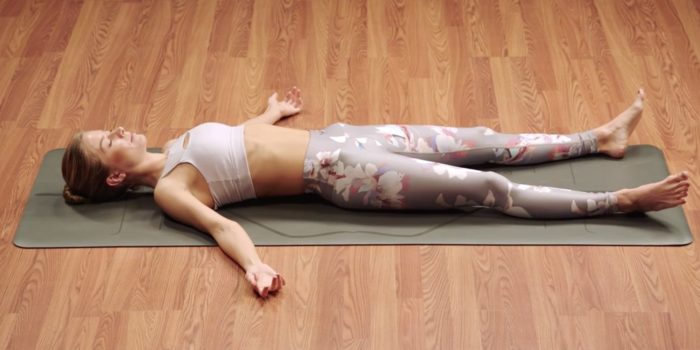
- Lie down on your mat.
- Let your arms rest slightly away from your torso, with your palms facing up. Relax your shoulders away from your ears.
- Separate your legs until your heels reach the corners of your mat.
- Close your eyes, and relax your entire body as you slow your breathing and rest for at least five minutes.
